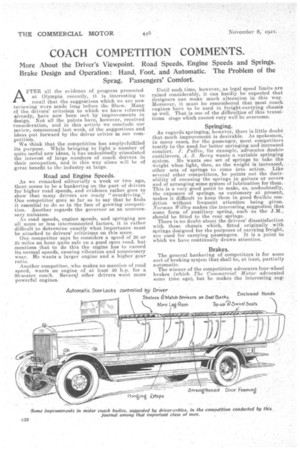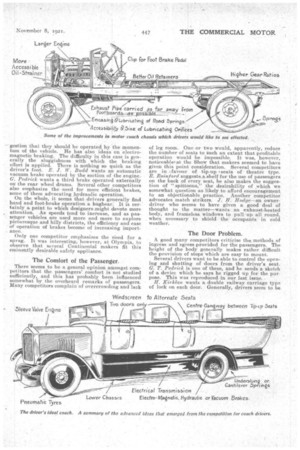COACH COMPETITION COMMENTS.
Page 24

Page 25

Page 26

If you've noticed an error in this article please click here to report it so we can fix it.
More About the Driver's Viewpoint. Road Speeds, Engine Speeds and Springs. Brake Design and Operation: Hand, Foot, and Automatic. The Problem of the Sprag. Passengers' Comfort.
AFTER all the evidence of progress presented at Olympia recently, it is interesting to recall that the suggestions which we are now reviewing were made long before the Show. Many of the drivers' criticism to which we have referred. already, have now been met by improvements in design. Not all the points have however, received consideration, and in this article we conclude our review, Commenced last week, of the suggestions and ideas put forward by the driver critics in our competition.
We think that the competition has amplytfulfilled its purpose. While .bringing to light a number of quite useful new ideas, it has undoubtedly stimulated the interest of large numbers of coach drivers. in their occupation, and in this way alone will be of great benefit to the: industry at large.
Road and Engine Speeds.
As we remarked editorially a week or two ago, there seems to be a hankering on the part of drivers for higher road speeds, and evidence rather goes to show that many drivers are really "overdriving." One competitor goes so far as to say that he finds it essential to do so in the face of growing competition. Another regards the governor as an unnecessary nuisance.
As road speeds, engine speeds, and springing are all more or less interconnected factors, it is rather difficult to determine exactly what importance must be attached to drivers' criticisms on this score.
One competitor says he considers a speed of 20 or 25 miles an hour quite safe on a good open road, but mentions that to do this the engine has to exceed its normal speeds, causing vibration and unnecessary wear. He wants a larger engine and a higher gear ratio.
Another competitor, who makes no mention of road speed, wants an engine of at least 50 h.p for a 30-seater coach. Several other drivers want more powerful engines.
Until such time, however, as legal speed limits are raised considerably, it can hardly be expected that designers can make much alteration in this way. Moreover, it must be remembered that most coach engines have to be used in freight-carrying chassis as well. That is one of the elifficulties of this transitions stage which cannot very well be overcome.
Springing.
As regards springing, however, there is little doubt that much improvement is desirable. As spokesmen,' in many cases, for the passenger, most competitors testify to the need for better springing and increased comfort. 1. Pullin, for example, advocates double cantilevers A. S. Berry wants a ,variable springing system. Fie Wants one set of springs to take the weight when light, then, as the weight is increased, other sets of springs to come into action. Like several other competitors, he points out the desirability of encasing the springs in gaiters or covers and of arranging some system of lubrication for them. This is a very good point to make, as, undoubtedly, the exposure of springs, as customary at present, makes it difficult to keep them in good flexible condition Without frequent attention being given. Norman. Willey makes the interesting suggestion that some form of auxiliary spring,. such as the JAL, should be fitted to the rear springs.
There is no doubt about the drivers' dissatisfaction with those chassis which, fitted originally with springs designed for the purposes of carrying freight, are used for carrying passengers. It is a point to which we have continually drawn attention.
Brakes.
The general hankering of competitors is for some sort of braking system that shall be, at least, partially automatic.
The winner of the competition advocates four-wheel brakes (which The Commercial Motor advocated some time ago), but he makes the interestilig sug
gestion that they should be operated by the momentum of the vehicle. He has also ideas on electromagnetic braking. The difficulty in this case is generally the sluggishness with which the braking effort is applied. There is nothing so quick as the driver's foot. E. 1. W. Budd wants an automatic vacuum brake operated by the suction of the engine. G , Pcdrick wants a third brake operated externally on the rear wheel drums. Several other competitors also emphasize the -need for more efficient brakes, some of them advocating ,hydraulic operation.
On the whole, it seems that drivers generally find hand and foot-brake operation a bugbear. It is certainly a point to which designers might devote more attention. As speeds tend to increase, and as passenger vehicles are used more and more to explore picturesque and hilly districts, the efficiency and ease of operation of brakes become of increasing importance.
Only one competitor emphasizes the need for a sprag. It was interesting, however, at Olympia, to observe that several Continental makers fit this eminently desirable safety appliance.
The Comfort of the Passenger.
There seems to be a general opinion amongst competitors that the passengers' comfort is not studied sufficiently, and this has probably been influenced somewhat. by the overheard remarks of passengers. Many competitors complain of overcrowding and lack
of leg room. One or two would, apparently, reduce the number of seats to such an extent that profitable operation would be impossible. It was, however, noticeable, at the Show that makers seemed to have given this point consideration. Several competitors are in.Lfavour of tip-up .seats of ' theatre type. R. Rainford suggests..ashelf for the use of passengers on the back of every seat, he also makes the suggestion of "spittoons," the desirability of ,which we somewhat question as likely to afford encouragement to an objectionable practice. Another competitor advocates match strikers. J. H. Hodge—an ownerdriver who seems to have given a good deal of thought to the matter—wants an exhaust-heated body, and frameless. windows to pull -up all round, when necessary to shield the occupants in cold weather.
The Door Problem.
A_ good many competitors criticise the, methods of ingress and egress provided for the passengers. The height of the body generally makes rather difficult the provision of steps which are easy to mount.
Several drivers want to be able to control the opening and shutting of doors from the driver's seat. G. T. Peelrick is one of these, and he sends a sketch of a device which he says he rigged up for the purpose. This was reproduced in our last issue. H. Kirklan wants a double railway carriage type of lack on each door. Generally, drivers seem to be apprehensive of some danger to passengers due to the• opening of doors when a vehicle is in motion.
Rather a good suggestion is that of D. MeAttiay, who wants to see a pamphlet entitled "Don'ts for Coach Tipp era.' Perhaps some day we shall be able to oblige him. There are certainly many points which might be brought, in such a way, to the attention of the careless passenger.
A Mechanical Miscellany.
Competitors, on the whole, have given less attention to mechanical matters than weshould have wished. A suggestion is made by .1. Smith that the main portions of the steering gear should be duplicated for safety's sake, but we are afritid most designers will not agree with him. A. S. Berry thinks that strainers should be placed in a, more accessible position than the engine sump, and he also.has views on the inconvenience of gearbox and rear axle oil • fillers. One competitor refers to the dangerous position of the petrol filter on the vehicle he drives. It is just over the exhaust pipe, and we agree with him that a, worse position for it would be hard to find. Several competitors refer to the difficulties of floorboard removal, and the ina-ccessibility of gearboxes when the petrol tank is positioned under the driver's seat.
Conclusions.
While it has been impossible, in the space at our disposal, to refer to every point raised by these driver critics, we think that sufficient has been said to show that there is much improvement which could be effected by looking at matters from the driver's point of view. In the evolution of the" better coach" no avenue to improvement must be left unexplored, and we hope that makers and designers will, accordingly, peruse this resume with interest.
































